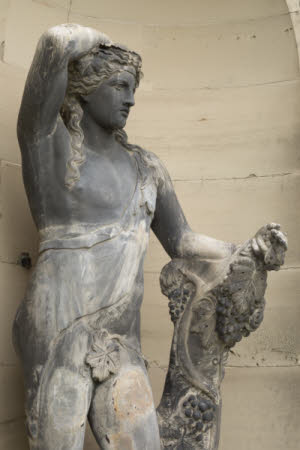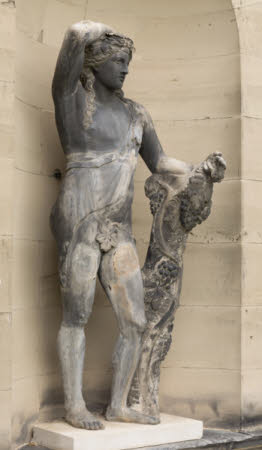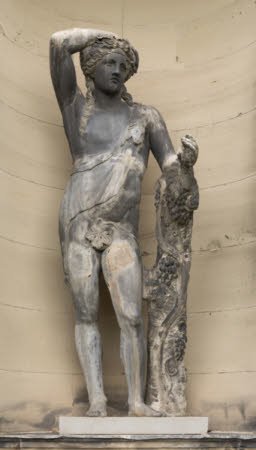Bacchus
John Cheere (London 1709 – London 1787)
Category
Art / Sculpture
Date
circa 1760 - circa 1763
Materials
Painted lead
Measurements
2030 x 950 x 480 mm
Place of origin
London
Order this imageCollection
Kedleston Hall, Derbyshire
NT 108712.2
Summary
Painted lead, Bacchus, John Cheere (1709-87) after the antique, c. 1760-63. One of a pair of statues by John Cheere of the Farnese Flora and Bacchus (with NT 108712.1). Cast in lead, painted white (of which traces remain); mounted on rectangular painted stone base. Colossal figure of Bacchus, Roman god of wine and revelry, as an androgynous youth, nude, with the exception of a goat skin draped across his torso. He stands in contrapposto, looking out to proper left. The proper right arm is lifted and bent at the elbow behind his head. The right forearm rests on a head of wavy hair, dressed with a headband and wreath of ivy or vine. Bacchus' proper left forearm rests on a tree trunk coiled with grape vines; he holds a bunch of grapes in his left hand. Cast after a Roman marble statue known as the Bacchus of Versailles in the French Royal Collection (Chateau de Versailles, invo.no. MR 105). See also casts at West Wycombe Park (NT 807674) and Stourhead (NT 562879).
Full description
John Cheere was the brother of the renowned sculptor and monumental mason Sir Henry Cheere (1703-81). He was one of mid-18th-century Britain’s leading sculptors in lead and ran a thriving workshop at London’s Hyde Park Corner, supplying many of the nation’s country houses with interior and exterior statuary. In keeping with Robert Adam’s designs for Kedleston (NT 109418, 109422, 109129) Cheere was engaged to produce a pair of statues in lead for the South Front portico (completed 1763) and a further suite of four classical statues for the North (NT 108726.1-108712.4). Nathaniel Curzon's handwritten 'List of Statues I have' (c. 1760) refers to statuary planned for the 'Two Niches on the South' initially being a figure of a 'Boy Fawn piping', rather than a Bacchus, and the 'Farnesian Flora'. By 1769 the 'Flora Farnese' and 'Antique Bacchus' are listed in the published 'Catalogue of the pictures, statues, &c. at Kedleston' of 1769. Bills predating this work show that between 1756 and 1758 Cheere had undertaken maintenance services for Nathaniel Curzon, cleaning plaster casts of the ‘Venus and Faun’ (NT 109004 or NT 109010 and NT 109003 or NT 109009), and had also been engaged to produce busts of Venus, ‘Zingara’, and a second ‘Busto of Venus without a head’. In September 1758 Cheere was commissioned to make two monumental lead pineapples, the procurement of fresh pineapples to study and mould being exactly half as expensive as making the final sculptures themselves (around £350 in today’s money) (MS, Kedleston Archive). Alice Rylance-Watson 2019
Provenance
Commissioned by Nathaniel Curzon, 1st Baron Scarsdale (1726-1804), between 1760 and 1763; identifiable in the published 'Catalogue of the pictures, statues, &c. at Kedleston' (1769) p. 4, 'Flora Farnese' and 'Antique Bacchus'; purchased with part of the contents of Kedleston with the aid of the National Heritage Memorial Fund in 1987 when the house and park were given to the National Trust by Francis Curzon, 3rd Viscount Scarsdale (1924-2000).
Credit line
Kedleston Hall, The Scarsdale Collection (acquired with the help of the National Heritage Memorial Fund and transferred to The National Trust in 1987)
Makers and roles
John Cheere (London 1709 – London 1787), sculptor


